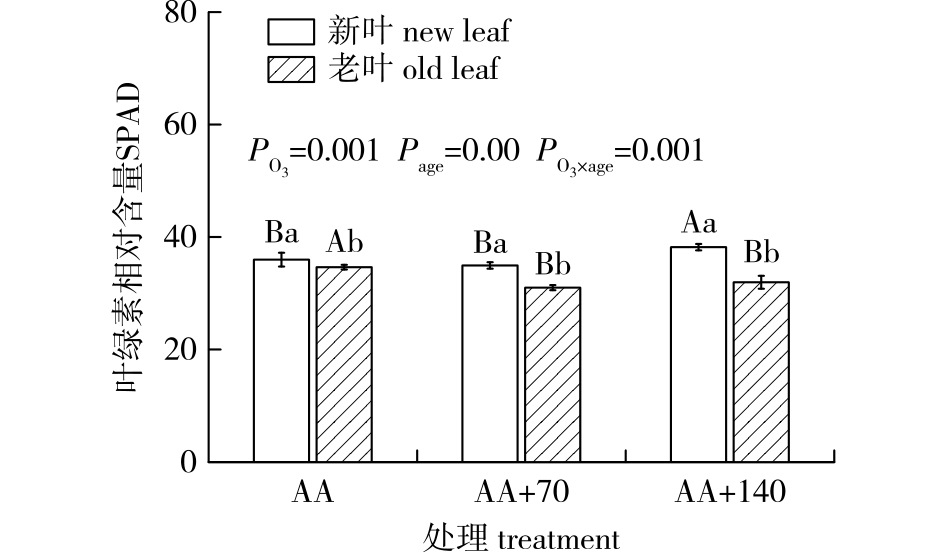【目的】不同叶龄竹类植物对大气臭氧(O3)污染的敏感性或响应可能存在一定差异,研究不同叶龄影响下的光合响应生理机制,为全面理解竹类植物对大气O3污染的响应机制提供参考。【方法】以美丽箬竹(Indocalamus decorus)为研究对象,开顶式静态箱内设置3种O3浓度处理:AA(大气背景),AA+70(增加70×10-9 O3)和AA+140(增加140×10-9 O3),检测老叶和新叶的叶绿素相对含量(SPAD)、气体交换及叶绿素荧光参数。【结果】①新老叶SPAD对O3浓度的响应不同,老叶SPAD在AA+70 和AA+140处理下分别下降了10.5%和7.8%(P<0.05),而新叶SPAD在AA+140处理下上升了6.3%。O3浓度升高(eO3)和叶龄对叶绿素SPAD存在交互作用,eO3增加了不同叶龄叶片SPAD的差异;②eO3显著降低了老叶的饱和光强下最大光合速率(Asat)和气孔导度(Gs),而对新叶无显著影响,可见导致老叶光合速率下降的主要原因是非气孔限制;③eO3显著降低了新叶和老叶的实际光量子产率(PhiPS2)、CO2同化的量子效率(PhiCO2)和光合电子传递效率(ETR),但是老叶下降的幅度大于新叶。另外,eO3降低了新叶的光化学猝灭系数(qP)。eO3和叶龄在PhiCO2具有显著交互作用,表现为eO3增加了新老叶龄的差异。【结论】新叶对eO3的响应要弱于老叶,叶龄是影响叶片气体交换和叶绿素荧光对eO3响应的重要因素,非气孔限制是美丽箬竹老叶Asat下降的主要原因。美丽箬竹在O3污染中存在对新叶明显的 “启动”和“补偿”效应,以保证植株的最大光合生长,这也是其生长迅速同时具有较强大气O3抗性的原因之一。美丽箬竹的抗O3特性和对新叶的快速补偿效应可提升其在污染地区的存活率,增加其作为“以竹代塑”原料的稳定性。
【Objective】Rapid industrialization and urbanization under climate change have intensified atmospheric pollution across many regions of China. Ozone(O3), a phytotoxic secondary pollutant with increasing concentrations, has become a major summer time air pollutant in urban areas, posing serious threats to ecological security. Leaves of different ages may exhibit varying sensitivity or responses to atmospheric ozone (O3) pollution, and the physiological mechanisms underlying age-related differences in photosynthetic responses remain to be fully elucidated. This is crucial for a comprehensive understanding of the response mechanisms of bamboo species to atmospheric O3 pollution. This study investigated the effects of elevated O3 concentration(eO3) on the urban landscaping bamboo species Indocalamus decorus to assess whether leaf age influences the O3 resistance of I. decorus, and to elucidate the mechanistic links between chlorophyll fluorescence parameters and photosynthetic impairment.【Method】Nine open-top chambers (OTCs) were established with three O3 treatments in a suburban area of Changping District, Beijing. The OTCs, constructed with aluminum alloy frames and covered with 10 mm thick transparent plastic film (90% light transmittance), were 2.5 m in height and 2 m in diameter, with a ground area of 3.14 m2 and spaced 2 m apart. I. decorus, a small evergreen ornamental bamboo with significant economic value in China and broad applications as a sustainable “bamboo-as-plastic” substitute, was selected as the study species. It is commonly used in food packaging, temporary shelters, boat canopies, hat weaving, and textile manufacturing. Rhizomes of uniform age (five years), color, and thickness were selected, and 10 cm segments with consistent length and bud number were propagated. After one year, uniform seedlings were transplanted for the experiment. During the growing season, chlorophyll content, gas exchange, and chlorophyll fluorescence parameters were measured in both mature and newly emerged leaves. In view of rising O3 levels in Beijing and the known O3 tolerance of I. decorus, the O3 treatments included ambient air (AA), AA + 70 ×10-9 O3 (AA+70), and AA + 140 ×10-9 O3 (AA+140). O3 fumigation was conducted daily from 8:30 to 17:30 (9 h), starting on June 1st and ending on October 12th.【Result】(1) SPAD values of old and new leaves exhibited contrasting responses to O3. Under AA+70 and AA+140 treatments, SPAD values of old leaves decreased by 10.5% and 7.8%, respectively (P<0.05), whereas SPAD values of new leaves increased by 6.3% under AA+140. A significant interaction between eO3 and leaf age was observed, with eO3 amplifying SPAD differences between leaf ages. (2) eO3 significantly reduced the maximum photosynthetic rate (Asat) and stomatal conductance (Gs) of older leaves under saturating light, but had no significant effects on younger leaves. The photosynthetic decline in older leaves was primarily attributed to non-stomatal limitations.(3) eO3 significantly decreased the actual quantum yield of PSⅡ (ΦPSⅡ), quantum efficiency of CO2 assimilation (PhiCO2), and electron transport rate (ETR) in both young and old leaves, with more pronounced reductions in older leaves. Additionally, eO3 reduced both photochemical quenching (qP) in young leaves. A significant interaction between eO3 and leaf age on PhiCO2 was observed, indicating that eO3 exacerbated the differences between young and old leaves.【Conclusion】Elevated O3 concentration induces chlorophyll degradation and PSⅡ photodamage in mature leaves, suppressing light reactions (reduced ΦPSⅡ) and electron transport (lowered ETR), thereby impairing photosynthesis. In contrast, new leaves exhibit compensatory mechanisms: preferential allocation of resources (e.g., photoassimilates and antioxidants) helps stabilize chlorophyll content and maintain Asat, sustaining overall photosynthetic performance. This leaf-age-dependent resource allocation strategy—prioritizing younger leaves—enhances population-level O3 tolerance in I. decorus, underscoring its ecological adaptability and reinforcing its potential as a sustainable “bamboo-based plastic alternative”. Future studies should investigate the long-term effects of O3 on chlorophyll fluorescence dynamics to better understand photosynthetic acclimation. This study provides precise data and theoretical support for understanding the impacts of air pollution on bamboo growth, offers a scientific foundation for the development of eco-friendly and sustainable bamboo industries, and contributes predictive insights into the effects of future climate change on urban green vegetation.
 PDF(1858 KB)
PDF(1858 KB)


 PDF(1858 KB)
PDF(1858 KB)
 PDF(1858 KB)
PDF(1858 KB)
